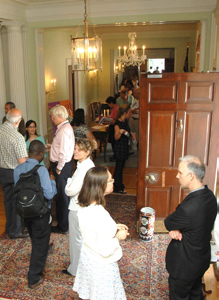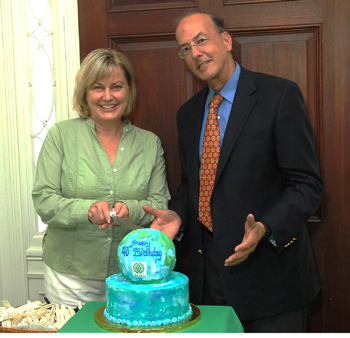| |
 |
|
|
|
|
| |
Guests fill Stone House entryway for party. |
|
Back in Fogarty’s heyday, Congress was much less partisan than today, and he won the admiration and cooperation of many Republicans concerned with health issues. The power of appropriators was so great and Fogarty’s likeability so wide that he single-handedly raised the NIH budget from $37 million to $1.24 billion during his chairmanship.
That he was such an ardent health research advocate
might not be expected from his background. Born in Providence, R.I., Mar. 23, 1913, Fogarty finished high school and, like his father, became a bricklayer. Within 10 years he was president of the statewide union.
Elected to Congress in 1940 at age 27, he won appointment 7 years later to the House appropriations
committee and its subcommittee that controlled
spending for NIH and other agencies in the old Department of Health, Education and Welfare.
Two years later he became the subcommittee’s youngest chairman and devoted himself to the task of dismantling the brick wall of congressional resistance to spending on health research.
Unusual for this day, or any day, he would badger friendly witnesses from NIH at budget time about why they were not asking for more money. The answer was that they were dutifully defending the request of the President, their ultimate boss. The result? A lot of money. Usually a lot more than the President had requested.
In addition to promoting research throughout his congressional career, Fogarty consistently urged funding for people with disabilities, both mental and physical, as well as for medical libraries.
 |
Helping cut the cake at FIC’s 40th birthday party are Amy Porter, executive director of the Foundation for NIH, and Dr. Roger Glass, FIC director.
Open House Photos: Michael Spencer |
By 1963, he was dreaming of “a great international
center for research...dedicated to international cooperation.”
He died suddenly on Jan. 10, 1967, at his office desk while preparing to re-introduce such legislation;
18 months later President Johnson created the John E. Fogarty International Center.
After his death, the New York Times editorialized: “No one in the history of this country has done more to promote more and better health services, more and better health facilities and more and better
health research than Representative Fogarty.”
Fogarty was prescient in arguing the needs and rewards of global health research a half century ago. Today, the center is extending his vision in a world made smaller and more interdependent by international trade, travel and the Internet.
From a starting budget of $500,000 to $67 million
today, the Fogarty Center supports more than 5,000 researchers in more than 100 countries.
It trains foreign scientists here and in their own countries with the aim of helping them strengthen
their own national research capacity and trains American pre- and postdoctoral students here and abroad with the aim of learning from and with others.
NIH involvement is essential, Fogarty director
Dr. Roger Glass told visitors. “It is one of the most effective means for our nation to help enable scientists in less developed countries create
the knowledge, institutions and relationships required for health improvement and economic development.”
Historic House Is Site of Fogarty Offices, Birthday Party
Stone House, the site of the Fogarty 40th birthday
party, is known formally as the Lawton Chiles
International House, and by the facilities people
as Bldg. 16.
That a building made of stone would house Fogarty
conferences and offices would have given the center’s namesake, Rep. John E. Fogarty, (D-RI) a laugh, as he began his career as a bricklayer.
The site was part of a land grant to Robert Peter, who came to America from Scotland in about 1745. The designer of the residence, Walter G. Peter, was a noted Washington architect, and it was built as a family residence in 1930 by his brother, the Rev. George Freeland Peter, a canon of the Washington Cathedral.
The government acquired the estate in 1949 to provide space for an expanding NIH.
With its locally quarried bluestone and two-story Corinthian columns, the house exemplifies the Colonial Revival estates that once lined the road between Bethesda and Rockville.
The three levels encompass nearly 17,500 square feet. Over the years, various alterations have been made to accommodate the house’s changing functions.
On the main floor, the former living room now extends the length of the South Wing, with French doors opening onto a spacious veranda and formal garden. Today, the room is used for conferences, seminars and receptions.
Leading from the main to the second level of offices is a freestanding, elliptical stairway with a mahogany railing. Also on the main level are a drawing room, dining room, library and kitchen.
From 1970 to 1978, scholars—including Margaret
Mead, Albert Sabin, four Nobelists and several Lasker winners—lived on the second floor, which had 7 bedrooms and bathrooms, a maid’s room, a morning room, a sitting room and a sewing room. 